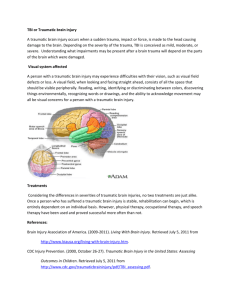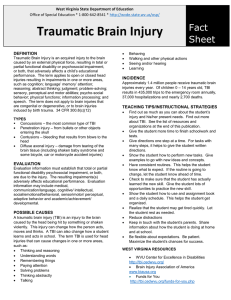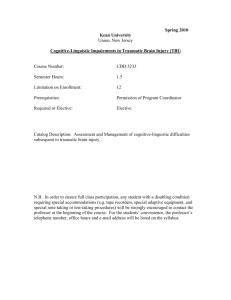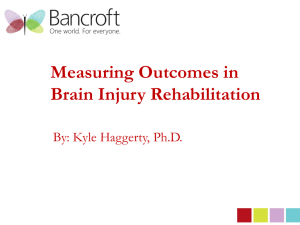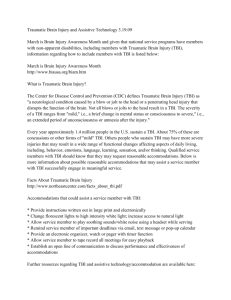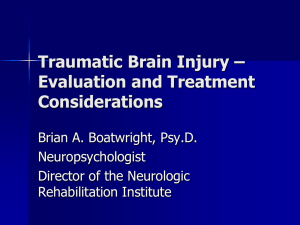T B I
advertisement
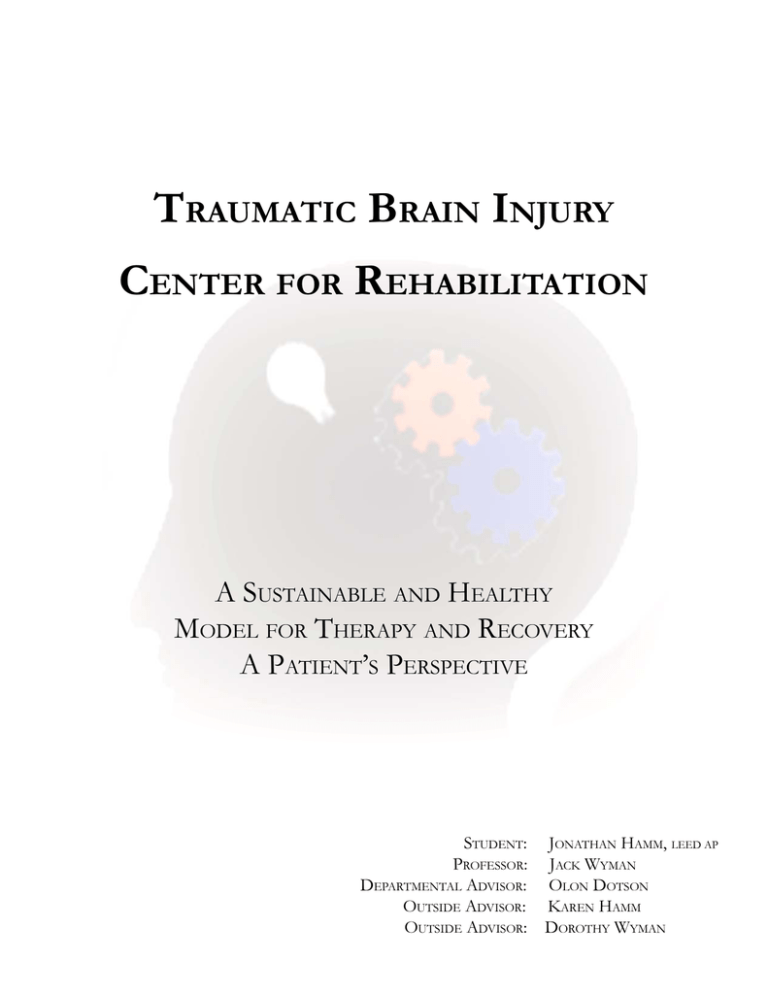
TRAUMATIC BRAIN INJURY CENTER FOR REHABILITATION A SUSTAINABLE AND HEALTHY MODEL FOR THERAPY AND RECOVERY A PATIENT’S PERSPECTIVE STUDENT: JONATHAN HAMM, LEED AP PROFESSOR: JACK WYMAN DEPARTMENTAL ADVISOR: OLON DOTSON OUTSIDE ADVISOR: KAREN HAMM OUTSIDE ADVISOR: DOROTHY WYMAN CONTENTS pg 04 pg 05 pg 06 pgs 7-9 pgs 10-13 pgs 14-19 pg 20 pg 21 pgs 22-25 pg 26 pgs 28-29 pgs 30-31 pg 32 pg 33 pgs 34-35 pgs 36-46 pgs 48-49 pg 50 pgs 52-53 Acknowledgements Abstract Process Discovery Notes Precedent Analysis Site Analysis Process Definition of Traumatic Brain Injury Consequences of Traumatic Brain Injury Program Definitions Graphic Program Solution Plans Patient Room Views Elevation Green Roof Section Sections Solution Renderings Proven Benefits Final Thoughts Bibliography ACKNOWLEDGEMENTS Right after my accident I promised God that if he would allow me to make something of my life I would tell anyone that would hear me it was through him. I beleive that all of my accomplishments have been achieved because he has allowed it. It is important to acknowledge my family for the support I have recieved from them throughout the time we have been at Ball State. I know living in the “shoe box” and all of the stress of having a husband and father in school has not been easy. BUT, and this is a big BUT we have made it!!! Karen thanks for the huge chance you took on me to make it through this program. Ronnie, I know there has not been much time for “goofing,” but we have survived. I hope this experience will prove to you what can be achieved when you really want it. There are three professors I would like to directly acknowledge: Olon Dotson- than you for all the positive support you have given me. Arijit Sen- thank you for helping me look at the world through other peoples’ eyes. Jack Wyman- you have been an inspiration to me. I deeply appreciate having been your student. Outside Advisors: Karen Hamm- sometimes words are not enough. Dorothy Wyman- thank you for all your help this year. It has been a pleasure to learn from you. I would like to thank the following people for their support and friendships throught the past four years. In Alphebetical Order: Jeremy and Racheal De Ryk Crystal Meyer Kayo Takumyo Eric and Melissa Wilson Matt Van Wienen 04 ABSTRACT Thesis Statement: Architecture Can Promote Recovery of Traumatic Brain Injuries Thesis Topic: Issues and Positions While recovering from a closed traumatic brain injury I observed that the locations and designs of the facilities were depressing. Not only was the injury an obstacle to the recovery process but so were the treatment facilities. The reasons for this included distance of travel from one therapy to the next and lack of communication between therapists and the physiatrist. The overall nature of the facilities was dark and depressing. These hardships were definitely a detriment to my recovery. Another detriment to the successful recovery of a person with a closed head trauma is slack time. The more a person is worked with early on, the better the chance of maximum benefit. In my thesis topic I investigated the design and formation of a Traumatic Brain Injury Rehabilitation Facility. The intent of the unit would be to prepare teens through adults to be reintegrated into the community after the initial recovery period. The initial recovery period was defined as that period of time in which the patient is in need of intense medical care. The design of the structure followed the sustainable building paradigm. The design of the project must also enhance the immediate environment of those persons that will be affected by the structure. I believe that sustainable architecture can have a dramatic and positive impact on the emotional and physical well being of persons whom are in need of medical rehabilitation. The reason I believe this to be true is that it has already been proven that employees working in a LEED certified building are more productive. Therefore, I designed a facility that uses the strategies of sustainability to enhance a patient’s recovery. I researched rehab and senior living facilities to observe the present conditions. These conditions became my baseline studies. From these studies I developed a new paradigm for rehabilitation facilities. The design includes the following spaces: Therapy, Neuropsychiatrist, Physiatrist, Inpatient Rooms, Outpatient Services, Visitation Space, Community Space, Care Giver Preparation Space, Counseling Room, Vocational Training Liaison, Legal Assistance, Temporary Child Care Services, and a small variety of retail spaces. There are areas that could be developed much further. The first and most obvious is the sun shading system for the east, west, and south sides of the building. Secondly, the nurses’ station could be developed to a level that would increase nurse to patient contact. Sustainability could be pushed to a much higher level. If I or anyone else was to continue working on this design I would suggest starting with sustainability. 05 DISCOVERY PROCESS NOTES It is important when considering day lighting to remember that the lighting from 2 Windows on two different walls is always more pleasant and healthy than one. This is because the two windows allow light to enter from two different types of skies. This allows a light to express its many moods, colors, and directions throughout the day. “If you want to institutionalize a building you need corridors from A to B to become a renewing preparatory experience you can use a cloister. Cloisters are semi outside spaces, around the garden; if glazed, they cease to be a cloister. None the less, we can build some of thier quality into passageways so that any future destination can take second-place of where you are now. (Day page 22). A quote from Winston Churchill says “We shape our environment and our environment shapes us. Environment can provide nourishment, support and balance for the human spirit as much as it can starve, oppress and pervert” (Day page 23). High architecture concerns itself with proportion geometry and classically differentiated elements representing universal principles: relation to the earth, to vault of the heavens, vertical boundaries of free stretching space, as experienced in the human limbs, head and torso; also to the finely tuned shape of space, former, and so on. This is the stream of great architecture temples, cathedrals, sometimes palaces and civic buildings. In scale and commitment to a singular idea such buildings often dominate the surroundings. Vernacular architecture concerns itself to response to climate, materials, social form and tradition. It concerns itself very much with textures, meeting of materials, and candidates to be rich for the senses (Day page 28). When designing a rehabilitation hospital one must take into account the limited mobility of persons being treated. The acute sensitivity to the physical environment for whom the building was intended. With the limited mobility of whatever becomes the design module and must be accounted for in all situations pertaining to the design. The degree to which each patient’s mobility is limited will be varied. The medical era of a rehabilitation center includes but is not limited to: physical therapy, speech therapy, occupational therapy, recreational therapy, Hydra therapy, and medical evaluation spaces and doctors office. Physical, speech, occupational, recreational therapy is by all the included in one large space referred to as a gymnasium (Crosby, Michael J. DeChiara, Joseph.). 06 PRECEDENT ANALYSIS Circulation Space does not allow for any form of transition between the private space of the patient’s room and the very public space of the common hallway. This lack of transition from public to private is very abrupt and uncomfortable. Patient Rooms are shown here for recognition purposes only and will be discussed in detail on pages 30-31. Nurse’s Station is positioned in a central location, causing a high distance to bed factor (DBF). This distance is directly related to the quality of care a patient receives. DBF is also a cause of excess work loads for nursing staff, this in turn can be related to the staff members job satisfaction. This type of patient wing is very efficient and may be appropriate for many circumstances. However for persons with a TBI this layout can become confusing and is very institutional. CIRCULATION SPACE PATIENT ROOM TRANSITION SPACE NURSE’S STATION 07 PRECEDENT ANALYSIS Architect Lewis J. Sarvis investigated the amount of travel time nurses were spending between the centralized nurses stations and the patient bed. He determined that nurses where spending as much as forty percent of their work day walking. A major goal in planning thus became the reduction of nurses’ travel in order to increase direct nurse-patient contact(Kliment page 137). Medical Planning associates developed a tool for determining the travel time and the cost of employee travel. Their method is called the distance to bed factor, which is simply a summation of distances from nursing work centers to beds divided by the number of beds(Kliment page 138). With great distance variations, some patients may receive more nursing observation than others. Therefor a goal of laying out patient wings is to minimize travel distances for nurses. This is beneficial for both economic and quality of patient care(Kliment page 139). 08 PRECEDENT ANALYSIS Notes and Observations from visit to Rehab Hospital of IN Due to patient privacy issues and security, I was unable to take photgraphs of the rehab facilities I visited. For this reason I have included my notes and observations. Gym 2 – Inpatient stroke/brain injury Kitchen w/ both wheelchair height cabinets and regular cabinets Laundry Mat tables for patient mobility and strength training. Private treatment rooms Car- this is a simulator to teach patients how to drive again. Gym 1 – Inpatient and Outpatient; orthopedics Different levels in ceiling for patients to look at helps deter boredom. Access to outside patio: uneven ground or outside walking All therapies combined in gym areas (occupational, speech, physical, recreational, etc.) Traumatic Brain Injury Unit – special doors which lock down if interloping patients with bracelets get too near Rooms with room for a wheelchair to turn around 360 degrees. Visitability issues Semi-private: share bathroom and closet space. Tables to eat and TV lounge in unit. Cafeteria – open to patients and families as well as staff; also have a separate vending machine area Center Court – round, well-lit open gathering space – outside garden with basketball court next to it (higher level balance) Retail center/gift area Pharmacy Radiology Laboratory (blood work) Separate hall with psychology and other offices Library with books, materials and computer access for families Ramps and different grade steps for patient therapy Info. Center/Waiting area – high ceiling with varied heights and artistic interest. One wall is rounded (bowed out). Wouldn’t recommend families staying with patients always as they often get in the way (take care of patient too much rather than expecting them to do for themselves). Landmarks/ Signage important 09 PROPOSED SITE FOR COMMUNITY RE-ENTRY SERVICES Muncie, Indiana currently does not have a center for persons with a Traumatic Brain Injury to recieve intensive therapy. This type of therapy is needed to help insure the injured person’s greatest chance for maximum recovery. This site was chosen due to its proximity with both Ball State University and Ball Memorial Hospital. 10 SITE ANALYSIS Site Considerations: Residential Area Located on the North and West Vehicular Traffic on the North and East heaviest traffic on East Vegetative Buffer on the South and West Site Drains to the South West Corner and is carried away by drainage ditch Sun Path follows typical Northen Hemisphere pattern Winter winds prevail from the North West Summer winds prevail from the South West The more significant site considerations were the location of the sun, prevailing winds. The building is positioned to take full advantage of the travel path of the sun. 11 FIGURE GROUND MAP 12 SITE NOISE AND TRAFFIC ANALYSIS 13 PROCESS The first conceptual design was to have two separate patient wings divided by a main service area. The patient rooms were large enough to be one, two, and three bedroom apartments. Patient rooms were organized in a rectangular pattern with a large amount of interior green space. The interior court yards provided areas for small retail, therapy, gathering spaces, and a connection to the outside. These things were provided in a safe area that would allow patients the maximum amount of freedom while still being in a controlled environment. These proportions made the design economically infeasible, and created an enormous work load for the staff. PLAN NOT TO SCALE Many of the ideas implemented in this first conceptual design were carried through to the completion of the project. In this sense the concept is not a complete failure. 14 MASSING MODEL NOT TO SCALE PROCESS After the first pinup, I began to take a more methodical approach. The diagrams on the left were used to determine space relationships. The red lines represent outpatients and visitors. This group of people would need access to every area of the building. The blue lines represent inpatients. Their access is far more limited and exclusive. The spaces most important to the inpatient group are: patient rooms, therapy area, cafeteria, and visitation. The yellow lines represent doctors. Although this group is not limited to their access they do have specific areas that are of more importance to them. For example: inpatient rooms, outpatient exam rooms, therapy area, administration, and cafeteria. 15 PROCESS Use of a octagon as the center of the building and circulation space (see Figure 1 middle right side of page) The idea was to use different geometries for each of the designated areas. This would distinctly change the view and allow for easier spatial recognition. I quickly discovered the inherent difficulties with this approach. One of the largest problems was that in order to use this system the octagon had to be very large, taking up valuable space. Another problem with this concept is that it would not be intuitively obvious to the patients that the space had changed shape. This then negated the idea of using distinct geometries as a tool for locating ones self. Figures 2 and 3 are dipictions of three other organizational ideas. Radial- Consists of a dominant central space from which a number of linear organizations extend in a radial manner. Radial organization is an extroverted plan that reaches out into its context. With its radial arms it can extend and attach itself to specific elements or features on its site (Ching page 209). Figure 1 Linear- Consists essentialy of a series of spaces. These spaces can either be directly related to one another or linked through a seperate and distinc linear space (Ching page 198). Clustered- Consist of repetitive, cellular spaces that have similiar functions and share a commmon visual trait such as shape or orientation (Ching page 214). 16 Figure 2 Figure 3 PROCESS The floor plan shown below was part of our third pin up. I used the radial ordering system with the nurses’ station (tan) as the center of the radius. The distance to bed factor was approximately 1.10. Each station was responsible for eight patients. The burgundy spaces are the typical patient rooms. Although this layout is very efficient, there are no direct views into the rest room or into the circulation space. Patients may feel isolated and suffer from a lack of stimulation. Since my thesis involved maximizing patient recovery this plan was not adequate. Patient Rooms Restrooms Circulation Space Nurses’ Station Support Space 17 PROCESS Graphic representation of my observations while visiting Rehab Hospitals. I hoped to plug the leaks and create better spaces for healing. 18 PROCESS FINAL CONCEPT 19 Definition of Traumatic brain injury (TBI): An insult to the brain, not of degenerative or congenital nature caused by an external physical force that may produce a diminished or altered state of consciousness, which results in an impairment of cognitive abilities or physical functioning. It can also result in the disturbance of behavioral or emotional functioning. Acquired brain injury (ABI) Definition: Injury to the brain which is not hereditary, congenital or degenerative that has occurred after birth. An Estimated 5.3 Million Americans currently live with disabilities resulting from a traumatic brain injury. This is a little more than 2 percent of the U.S. population. 1.5 Million Americans sustain a traumatic brain injury each year. Each year, 80,000 Americans experience the onset of long-term disability following TBI. More than 50,000 people die every year as a result of TBI.1 The risk of TBI is highest among adolescents, young adults and those older than 75.2 After one brain injury, the risk for a second injury is three times greater; after the second injury, the risk for a third injury is eight times greater.3 The cost of traumatic brain injury in the United States is estimated to be $48.3 billion annually. Hospitalization accounts for $31.7 billion, and fatal brain injuries cost the nation $16.6 billion each year.4 Vehicle Crashes are the leading cause of brain injury. Falls are the second leading cause, and the leading cause of brain injury in the elderly. (Footnotes) 1 Centers for Disease Control. “Traumatic Brain Injury in the United States: A Report to Congress.” www: Centers for Disease Control, (January 16, 2001) http: www.cdc.gov/ncipc/pub-res/tbicongress.htm. 2 Analysis by the CDC National Center for Injury Prevention and Control, using data obtained from state health departments in Alaska, Arizona, California, Colorado, Louisiana, Maryland, Missouri, New York, Oklahoma, Rhode Island, South Carolina and Utah. 3 Annegers JF, Garbow JD, Kurtland LT et al. The Incidence, Causes and Secular Trends of Head Trauma in Olstead County, Minnesota 1935- 1974. Neurology. 1980; 30:912-919. 4 Lewin –ICF. The Cost of Disorders of the Brain Washington, DC: The National Foundation for the Brain, 1992. Professor Jack Wyman http://www.adap.net/tbi/braininjury.pdf http://www.recreationaltherapist.com 20 Percentage of TBI Causes5 44% 26% 13% 9% 8% Transportation Falls Other or Unknown Non Firearm Firearms (Brain Injury Association of America, pgs. 1&2) The Consequences of Brain Injury Cognitive Consequences Can Include: Short-term memory loss; long-term memory loss Slowed ability to process information Trouble concentrating or paying attention for periods of time Difficulty keeping up with a conversation; other communication difficulties such as word finding problems Spatial disorientation Organizational problems and impaired judgment Unable to do more than one thing at a time A lack of initiating activities, or once started, difficulty in completing tasks without reminders Physical Consequences Can Include: Seizures of all types Muscle spasticity Double vision or low vision, even blindness Loss of smell or taste Speech impairments such as slow or slurred speech Headaches or migraines Fatigue, increased need for sleep Balance problems Emotional Consequences Can Include: Increased anxiety Depression and mood swings Impulsive behavior More easily agitated Egocentric behaviors; difficulty seeing how behaviors can affect others (Brain Injury Association of America, pg 2) As the above quote shows traumatic brain injuries are of major consequence to our society. It has been estimated that less than 15% of persons with a traumatic brain injury ever become productive citizens. Of that 15% less than 2% are able to return to the pre-injury level of productivity. (Jack Wyman) With statistics like this it seems apparent that there are drastic changes that need to be made in the process of recovery. Architecture and good design can be a key factor in this recovery. Throughout this year I explored ways in which my future profession can improve people’s quality of life. 5 Personal Communications with Dr. David Thurman, CDC - National Center for Injury Prevention and Control, June 29, 1999. 21 Program Definitions: Multi-Family Housing- Often families that are affected by this type of injury incur great economic hardships. The stress this causes the family and the injured person has a negative impact on recovery. Also, the current practice of placing the injured person in a group home environment seems counterproductive to their eventual reintroduction to society. Physiatrist - the team leader in the rehabilitation program. The physiatrist is a physician specializing in physical medicine and rehabilitation. Physiatrists treat a wide range of problems, including the changes after brain injury. The physiatrist will assess and prescribe the treatment and direct the team. (TBI. com pg 3) Nueropsychologists - key member of the rehabilitation team. The Nueropsychologists will assess the patient’s changes in thinking and behavior. Changes could include: Poor memory Poor attention and concentration Poor decision-making Impulsivity Disorientation Language and communication abilities Inability to speak Inability to understand when spoken to Many patients are unaware of the changes in the brain and how those changes affect their daily lives. A patient may not understand what has happened and may be distraught by being away from home. Through education and counseling, the Nueropsychologists can help assure the patient and the patient’s family. (TBI.com 3) 22 Program Definitions: Rehabilitation Nurse - assists patients with brain injury and chronic illness in attaining maximum optimal health, and adapting to an altered lifestyle. The Rehabilitation Nurse provides care for the patient on the nursing unit. The focus of nursing care is on: Health maintenance Nutrition Potential for aspiration Impaired skin integrity Bowel and bladder incontinence Impaired physical mobility Impaired or limited ability to take care of self Ineffective airway Sleep pattern disturbance Chronic pain Impaired cognition Impaired verbal communication and comprehension Sexual dysfunction (TBI.com 3) Physical Therapist- works with people with orthopedic problems, such as low back pain, knee injuries or pain reduction. With traumatic brain injury, the PT’s job is to minimize or overcome paralyzing effects related to the brain injury. Physical therapists are experts in the examination and treatment of musculoskeletal and neuromuscular problems that affect the abilities to move and function in daily life. Physical therapists help with transfers to and from the bed when a patient cannot walk alone. They train a person to begin to walk and move more normally. PTs will assess: Balance Posture Strength Need for a wheelchair, brace or cane Quality of movement Spontaneous movement Coordination of movement Increased sensation of sensory-motor activities Pain management (TBI.com 3) 23 Program Definitions: Occupational Therapistassesses functions and potential complications related to the movement of upper extremities, daily living skills, cognition, vision and perception. OTS helps determine, with the patient, the best ways to perform daily living skills including showering, dressing and personal hygiene. The OT will identify equipment for eating, dressing and bathing. The OT also will look at skills to prepare the patient for a return to the home. These skills include: Cooking Grocery shopping Banking Budgeting Readiness for returning to work by assessing prevocational and vocational skills (tbi.com 3) Speech TherapistAssesses the ability to communicate with other people, helps to determine if the patient is able to swallow, works with the patient’s cognitive abilities. The Speech therapist will help with strategies for compensating for cognitive losses. The focus is on: Strategies to improve memory Poor attention and concentration Language and communication abilities Relearning to speak Ability to understand when spoken to Recreational TherapistAssists patients to engage in leisure activities such as cooking, arts and crafts, and music therapy that can provide a cognitive component to the “work” of physical rehabilitation. (recreation therapist.com pg1) community centerThis will be a somewhat typical community center. It should be designed with function in mind. Child Care CenterChild care can become a major problem for families that are trying to rebuild after an injury. By placing a child care facility on site the worry of taking care of children can be eliminated. This will also allow for the family to stay united. 24 Program Definitions: counseling areasCounseling for the immediate family members is of extreme importance. They need to understand the changes in their injured family member. They also may need to grieve over the loss of key features, of the person with the injury, personality and talents. legal assistanceLegal aid is needed to deal with insurance companies, workman’s compensation boards, possible loaning institutions, child placement and other problems. medical facilitiesThere is a need for onsite emergency medical facilities. Patients may easily be re-injured after the initial injury. They also may have a complicated number of other contributing factors that need medical attention. out patient servicesOut patient services should also be offered for those families that live close enough to the site. This would help lower the cost for them and offer more space for those in need. care giver preparationThe care giver is an intricate part of the recovery process. A person can not be discharged home without having an appropriate care giver. In cases of paralysis, the care giver needs to be taught how to move, feed, help with hygiene and other needs the patient may no longer be able to do themselves, (Jack Wyman) 25 COMMUNITY RE-ENTRY SERVICES Facility Program Space Use DWG Quantity Exstension (NSF) Function / Activities PHYSIATRISTS OFFICE NUEROPSYCHOLOGISTS Allocation (NSF) 720 720 1 1 720.00 720.00 SPEECH THERAPY 180 3 540.00 COGNITIVE THERAPY 180 3 540.00 OCCUPATIONAL THERAPY 2250 1 2250.00 PHYSICAL THERAPY 2250 1 2250.00 RECREATIONAL THERAPY 3000 1 3000.00 EMERGENCY CARE FACILITY 1500 1 1500.00 REHAB NURSE PATIENT SUITE FAMILY SUITE PATIENT SUN ROOM CAFETERIA COMMUNITY ROOM CHILD CARE CENTER COUNSELING AREA LEGAL ASSISTANCE VOCATIONAL REHABILITATION CARE GIVER PREPARATION OUT PATIENT SERVICES TBI GROUP SUPPORT CONFERENCE ROOM VISITATION RETAIL PATIENT SERVICES ADMINISTRATION 200 480 480 480 2250 2250 1000 180 180 180 4 30 10 16 1 1 1 2 1 1 800.00 14400.00 4800.00 7680.00 2250.00 2250.00 1000.00 360.00 180.00 180.00 1200 2000 500 400 1 1 1 2 2700 3500 2 1 1200.00 2000.00 500.00 800.00 1190.00 5400.00 3500.00 Person in charge of overall rehabilitation of patient Person in charge of determining total amount of brain damage Private room for therapist and patient/one family member Private room for therapist and patient/one family member Private room for therapist and patient/one family member Private room for therapist and patient/one family member Private room for therapist and patient/one family member Used for immediate medical only to stabilize patient for transport Station for on duty nursing staff Patient private living area visitable Patient private living area visitable Patient private living area visitable Staff private ling quarters for 24 hour staff Area for group activities and recreational function Child care for family consultation times Psycological Counseling for Patient and Family Legal Counseling for Patient and Family Provides assistance for potential job counseling and assistance Used to train permanent care giver Patients on a walk in bases Group counseling area Space for medical teams, Patients, and Family to meet Space for Visitation and Relaxation Retail spaces for patients, their family and staff Space for general administrative duties Gross / Net Spaces (G/N) 60010 Main Mechanical Equipment Mechanical Duct Shaft Main Electrical Equipment Main Plumbing Equipment Elevators (1/floor) Elevator equipment room X X X X D D 0 25 100 100 45 95 1 3 1 1 2 2 0 75 100 100 90 190 Public Restrooms - Multipurpose Public Restrooms - General Use Custodial Closet Exit Stairs Circulation/Structure/Walls REST-1 PL-1 JN-1 X X 125 40 50 350 2 4 4 4 250 160 200 1,400 9,386 Subtotal (G/N) 26 71961 Enclosed room for air handling equipment for facility. One per floor so duct. Incoming electrical service. Incoming water service. Space for elevators on each floor. (5’-8” x 7’x8” shaft) One for each hydraulic elevator equipment (7”-0” x 9’-0”) basement. On same floor as Multipurpose Room. One per gender. On other public access floor(s). One per gender. Mop closet on each occupied floor. Two per floor required by code. Corridors, walls, and structure. 27 SOLUTION PLANS OUT PATIENT AND SUPPORT SERVICES EMERGENCY ROOM MAIN STREET CIRCULATION SPACE PATIENT ROOMS PATIENT SUN ROOMS PATIENT PORCH/GATHERING SPACE RETAIL AND STAFF SUPPORT SPACE 28 SOLUTION PLANS 29 PATIENT ROOM VIEWS 30 PATIENT ROOM VIEWS 31 ELEVATION Elevation not shown to scale 32 GREEN ROOF SECTION Green roofs, also known as vegetated roof covers, eco-roofs or nature roofs, are multi-beneficial structural components that help to mitigate the effects of urbanization on water quality by filtering, absorbing or detaining rainfall. They are constructed of a lightweight soil media, underlain by a drainage layer, and a high quality impermeable membrane that protects the building structure. The soil is planted with a specialized mix of plants that can thrive in the harsh, dry, high temperature conditions of the roof and tolerate short periods of inundation from storm events.1 1 Exploring the Ecology of Organic Green Roof Architecture, Green Roofs Web Site, (www.greenroofs.com), Velazquez 33 SOLUTION SECTION NURSES’ STATION CIRCULATION SPACE PATIENT SUITE INTENSIVE GREEN ROOF SUN ROOM SECTION A •Nurses Station- signage is an important factor for TBI patients. The nurses station is brightly colored and easily accessible. •Circulation Space- designed as a day lit streetscape. Reduces the cooling load by using natural daylight. The nano-gell kalwal system is designed for minimal heat gain. The use of daylighting has been proven to relieve depression and stress. •Patient Suite- warm, bright colors create a feeling of well being. With the added touches of home the environment is conducive of therapies and familiarity. •Intensive Green Roof- benefits include: Improved storm water management, lessens the heating and cooling loads, allowing the down sizing of HVAC and extending the life span of the roof. No additional structural components are necessary, the “green” roof replaces the ballast of an EPD roof membrane. •Sun Room- Provides the patient with the opportunity to be outside while being in a safe secure space. The patient can practice taking care of plants as a way to begin to accept more and more responsibility for their own lives. The wall between the sunroom and the patient suite is utilized as a thermal mass. 34 SOLUTION SECTION •Courtyard- Allows the patients and their families to adjust to the patients’ growing self sufficiency while providing security. The courtyard also serves as an interior light-well allowing all occupied spaces to be day lit. •Main Street- serves as a circulation/ gathering space designed to be easily navigated. This space is the hub of the Rehabilitation Center, as all of the therapy areas and doctors’ offices are located off of this core. The widened corridor allows for daily access to the cafeteria for resupply and trash removal at scheduled intervals. The atrium is used as a light court, utilizing daylighting to reduce energy use through skylights. Double story space creates a vertical "chimney" effect with low intakes and high outlets to facilitate natural ventilation. •Staff Training- large space used for staff training and break areas. It is important to create an environment that draws talented and dedicated people to work in the center. As the incidence of TBI increases and there are more facilities built, it will become increasingly difficult to recruit and keep staff members. Stress levels can be reduced by providing space for the staff to remove themselves from the main patient areas. In turn, happier staff will provide patients with better care. •Therapy pool- Patients, their families, and staff can use the hospital pool. The pool is between two and five feet deep and is heated to a soothing 93 degrees. It is equipped for aquatic therapy, swim lessons, family recreation, and adult water fitness. •Changing Room- private area for those using the pool to dress, while allowing a therapist to be close by. •Wheelchair Repair- provides an area to repair and adjust wheelchairs on site. ADMINISTRATION MAIN STREET THERAPY POOL CHANGING ROOM STAFF TRAINING PATIENT WAITING DOCTOR’S OFFICE COURTYARD SECTION B 35 SOLUTION RENDERING Patient Room Patients will recover faster in an environment that is familiar to them; this can be accomplished by allowing the patient’s family members to bring items from home. Architecturally, this can be achieved by designing access ways to be large enough to accommodate pieces of furniture. 36 SOLUTION RENDERING Patient Room 37 SOLUTION RENDERING Patient Room Each patient’s room can and should be modified to suit the individual. This can be accomplished by simply allowing the family members and the patient to decorate the room. The decorations should be as close to home as possible in order to provide a familiar comfortable environment. The walls can be painted in colors that are uplifting to the patient. These ideas may seem extreme, but remember the patient may be in this room for up to a year or more. 38 SOLUTION RENDERING Patient Room The sun room has multiple benefits: 1. Patients are able to chose to visit with their neighbor in a common space. 2. Studies have proven that exposure to sun light relieves depression and improves health. 3. Allows patients to have a “normal” space to visit their children while being discreetly supervised. 4. Patients can begin to take more and more responsibility by learning to take care of plants. 5. Provides passive solar heating when combined with the thermal mass of the wall and concrete. 39 SOLUTION RENDERING South West Exterior 40 SOLUTION RENDERING South West Exterior 41 SOLUTION RENDERING South West Exterior 42 SOLUTION RENDERING North West Exterior 43 SOLUTION RENDERING Conceptual Main Street Interior The Main Street concept is that all of the main service spaces come directly off of this central location. Main service spaces include: therapy gyms, cafeteria, doctors’ offices, and the community room. The distance across the space is 30 feet, broken down into three 10 foot sections. The sides of the section provide a pedestrian street. The center section serves as gathering space and contains access to the second floor. 44 SOLUTION RENDERING North West Street Interior North West Street contains both patient and family support services. Each service has a different facade similar to those we find on our streets everyday. This is used as a way finding tool, serving to help the patient be oriented. If all of the streets were the same this could be very confusing and disorienting. 45 SOLUTION RENDERING North West Interior 46 47 PROVEN BENEFITS There are certain implicit benefits from using LEED and green building in general. By encouraging a holistic design approach and measuring progress, LEED facilitates integrated design from start to finish. LEED also requires that a building under go final commissioning before the owner takes possession of the building. Commissioning ensures that the building performs exactly as it has been designed to do and provides third party validation. There are also many local, state, and federal incentives and funding for LEED Certified buildings. The Organization gains market exposure through the USGBC web site, publications, and media articles. Using LEED ensures that the building will have a low impact on its occupants and the environment, as well as a positive economic impact over the life cycle of the building. Patients: When patients are being treated in a LEED building, it has been found that they are released 2.5 days earlier on average and 10% less medication is used. The patients also call the nurse to their room fewer times than in a traditional hospital setting. LEED buildings have also been found to reduce respiratory diseases between 10-30%, which results in less time taken away from therapy. As an added benefit to the patients insurance provider it has been shown that these companies can save approximately 17-43 billion dollars in heath care savings. Staffing: The benefits carry over into the area of staff productivity and cost benefits to the hospitals. Companies have seen an increase in their productivity by as much as 30% after moving into a green building. This sum is huge to the bottom line, especially for those hospitals that are having financial problems. Just an increase of 3% increases an employee’s productivity by 10-15 minutes per day everyday. This equals out to an hour per week, and an additional week per year. Employee absenteeism also drops on average of at least 15%. LEED buildings also help to attract top performers in their profession. Financial: Green Buildings have a variety of financial benefits that conventional buildings do not. Including: Engergy Savings, Reduction in Emissions, Water savings, and a reduction in operation and maintenence costs. These savings can add up to 10 times the initial cost increase that may come with constructing a green building. Staffing issues also greatly effect the financial bottome line. 48 PROVEN BENEFITS Students: Studies have shown improvements in students that attend LEED certified schools. These improvements include: 7-18% increase on standardized test scores, and a 15-25% faster overall time for comprehension. In schools that have chosesn to impelment only day lighting standardized test sores have increased by 14%. Although these studies where not directly related to TBI patients, it seems reasonable that the same results are more than feasible. 49 FINAL THOUGHTS I have been learning about TBI for the past four years and eight months. Approximately nine months after my accident, I began studying architecture at Ball State University’s College of Architecture and Planning. Throughout this period of time I have often thereorized how good design might affect the recovery of a person with a TBI. My original thesis statement was, “I believe that regenerative architecture can have a dramatic and positive impact on the emotional and physical well being of persons whom are in need of medical rehabilitation.” The discovery process I used as my methodology for my thesis has led me to conclude that my original statement is fact. LEED certified buildings do have a dramatic and positive impact on the emotional and physical well being of people. Green design has far more benefits to society than just economic. Architecture is concerned with the quality of life of those the built environment affects. The notion of sustainablity may be the greatest step forward in architectural history toward the goal of improving quality of life. 50 51 Bibliography Brawley, Elizabeth C. “Strategies for Creating Better Care Environments” Designing for Alzheimer’s Disease. New York, New York: John Wiley & Sons Inc., 1997. Benyus, Janine M. “Innovation and Inspired by Nature” Biomimicry. New York, Collins Publishers, 2002. New York: Harper Canetor, David N. Sander, editors. Designing for Therapeutic Environments. York: John Wiley & Sons, 1979. New York, New Cohen, Uriel and Gerald D. Weisman. Environments for People with Dementia: Case Studies. University of Wisconsin, Milwaukee: Center for Architecture and Urban Planning Research, 1988. Day, Christopher. Places of the Sole . Northamptonshire, England: The Aquarian Press, 1990. Harris, Jonathan M., Timothy A. Wise, Kevin P. Gallagher, and Neva R. Goodwin. A Survey of Sustainable Development: Social and Economic Dimensions. Washington: Island Press, 2001. Harrison, Neil E. Constructing Sustainable Development. Albany, NY: State York Press, 2000. University of New Harrell, George T. Planning medical Center facilities. University Park and London: Pennsylvania State University Press, 1974. Harvey, Brian and John D. Hallett. Environment and Society: An Introductory Cambridge, MA: The MIT Press, 1977. Analysis. Hoffman, Leslie, publisher. Sustainable Architecture, White Papers. New York, Pledge Foundation, November 2000. New York: Earth Kliment, Stephen A. “Building Type Basics for” Health-Care Facilities. New York, New York: John Wiley & Sons, 2000. Lstiburek, Joseph W. Moisture Control Handbook. New York: Van Nostrand Lstiburek, Joseph W. Builder’s Guide: Cold Climates. Ellington, MN: Energy and Environmental Building Association, 1997. 52 Reinhold, 1993. Marberry, Sara O. Innovation and Health Care Design. New York, New York: Reinhold, 1995. Van Nostrand McDonough, William and Michael Braungart. Cradle to Cradle. New York, NY: 2002. North Point Press, McGregor, Alisdair et al. “Designing to Sustain.” Urban Land December 1998: 50-55, 90. Middletown, Neil and Phil O’Keefe. Redefining Sustainable Development. London and Sterling, VA: Pluto Press, 2001. Salmon, Christine F. and Cuthbert F. Rehabilitation Center Planning. University Park, Pennsylvania: The Pennsylvania State University Press, date not found. US Department of Health, Education and Welfare. “Guidelines the functional programming equipping and designing” Hospital Outpatient Emergency Activities. Washington, DC: Public Health Service, 1971, 1972. 53 54

